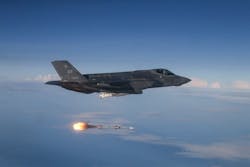Raytheon to build AIM-9X infrared-guided missiles that work with jet fighter pilot helmet-mounted displays
PATUXENT RIVER NAS, Md. – U.S. Navy aerial warfare experts are asking Raytheon Technologies Corp. to build 571 AIM-9X precision short-range infrared-guided air-to-air missiles for jet fighters and other combat aircraft under terms of a $263.7 million order announced in December.
Officials of the Naval Air Systems Command at Patuxent River Naval Air Station, Md., are asking the Raytheon Missiles & Defense segment in Tucson, Ariz., to build lot 23 AIM-9X block II air-to-air missiles for the U.S. Air Force, Navy, and foreign allies.
The AIM-9X is an infrared-guided heat-seeking missile that equips most jet fighters, fighter-bombers, and other offensive combat aircraft in the U.S. arsenal, and is for shooting down enemy aircraft close-by. The heat-seeking AIM-9X works by homing in on an enemy aircraft's hot engine exhaust. Variants of the AIM-9 Sidewinder have been deployed since the 1950s.
The order is for 571 AIM-9X block II all up round tactical missiles -- 91 for the Navy, 257 for the Air Force, and 223 U.S. allies; 48 block II captive air training missiles -- 38 for the Navy and 10 for the Air Force; 185 all-up-round containers -- 62 for the Navy, 67 for the Air Force, and 56 for U.S. allies; 11 spare advanced optical target detectors -- five for the Navy and six for the Air Force; eight spare advanced optical target detector containers -- two for the Navy, and six for the Air Force; 31 spare block II live-battery guidance units -- 21 for the Navy and 10 for the Air Force; 54 spare inert-battery block II captive air training missile guidance units -- 41 for the Navy and 13 for the Air Force; two block I tactical sectionalization kits for the Air Force; seven block II tactical sectionalization kits -- four for the Navy, two for the Air Force, and one for U.S. allies; 10 block II captive air training missile anti-tank missile sectionalization kits -- nine for the Navy and one for U.S. allies; one support equipment for U.S. allies; three other lot spare assets for the Navy, Air Force, and one U.S. ally; and non-recurring engineering.
The AIM-9X is among the latest versions of the AIM-9 missile family. It entered service in 2003 on the Navy F/A-18C Hornet fighter-bomber and on the U.S. Air Force F-15C jet fighter. It has an imaging infrared focal plane array seeker with 90-degree off-boresight capability for accuracy.
The missile is compatible with helmet-mounted displays such as the U.S. Joint Helmet Mounted Cueing System, and features 3-D thrust-vectoring control for increased turn capability. The AIM-9X also includes an internal cooling system.
This contract involves some of the latest versions of the AIM-9X, called the AIM-9X block II, with lock-on after launch capability for use with the F-35 Lightning II joint strike fighter and the F-22 Raptor advanced tactical fighter.
On this contract Raytheon will do the work in North Logan, Utah; Tucson, Ariz.; Linthicum Heights, Md.; Minneapolis; Murrieta, Calif.; Saint Albans, Vt.; Ann Arbor, Mich.; Warrington, Pa., and other U.S. locations, and should be finished by August 2026.
For more information contact Raytheon Missiles & Defense online at www.raytheonmissilesanddefense.com, or Naval Air Systems Command at www.navair.navy.mil.

John Keller | Editor-in-Chief
John Keller is the Editor-in-Chief, Military & Aerospace Electronics Magazine--provides extensive coverage and analysis of enabling electronics and optoelectronic technologies in military, space and commercial aviation applications. John has been a member of the Military & Aerospace Electronics staff since 1989 and chief editor since 1995.

